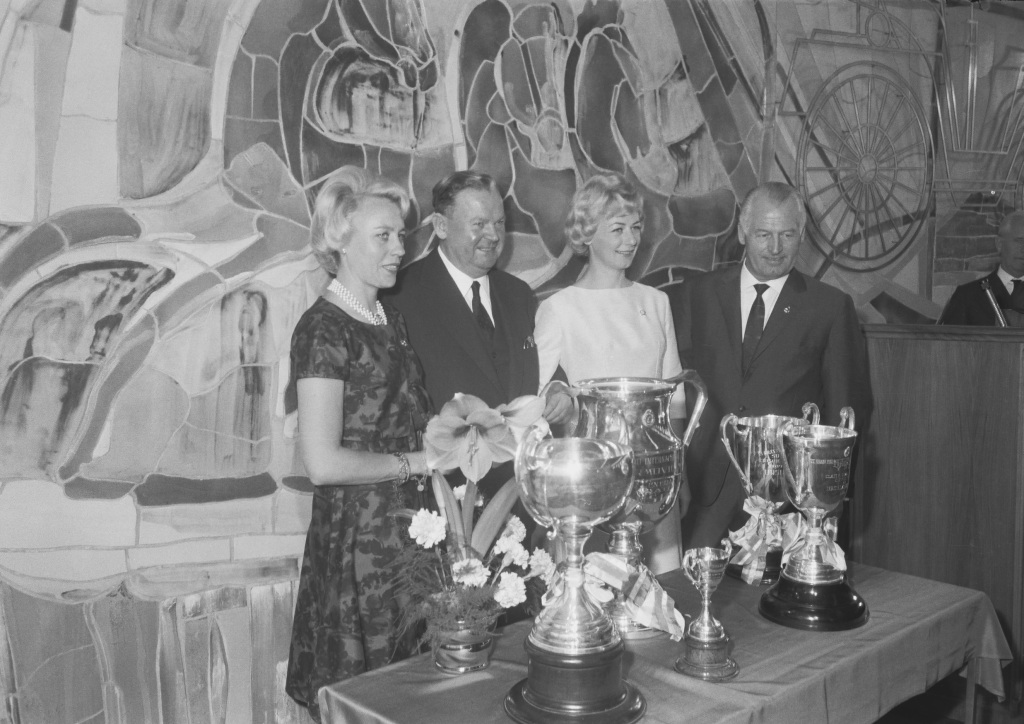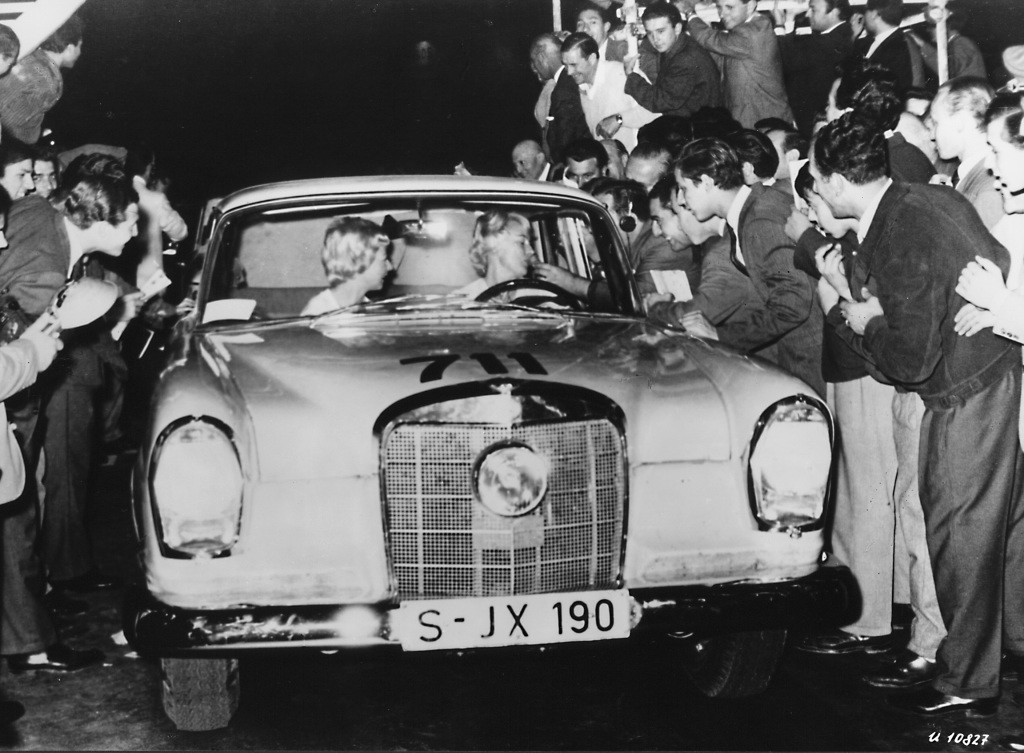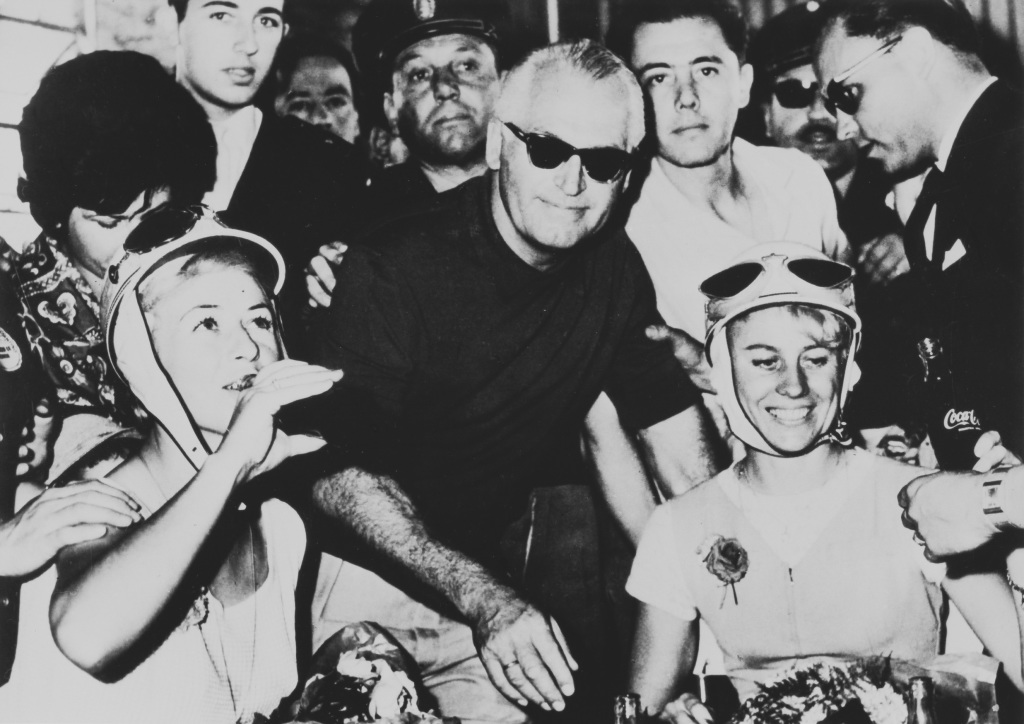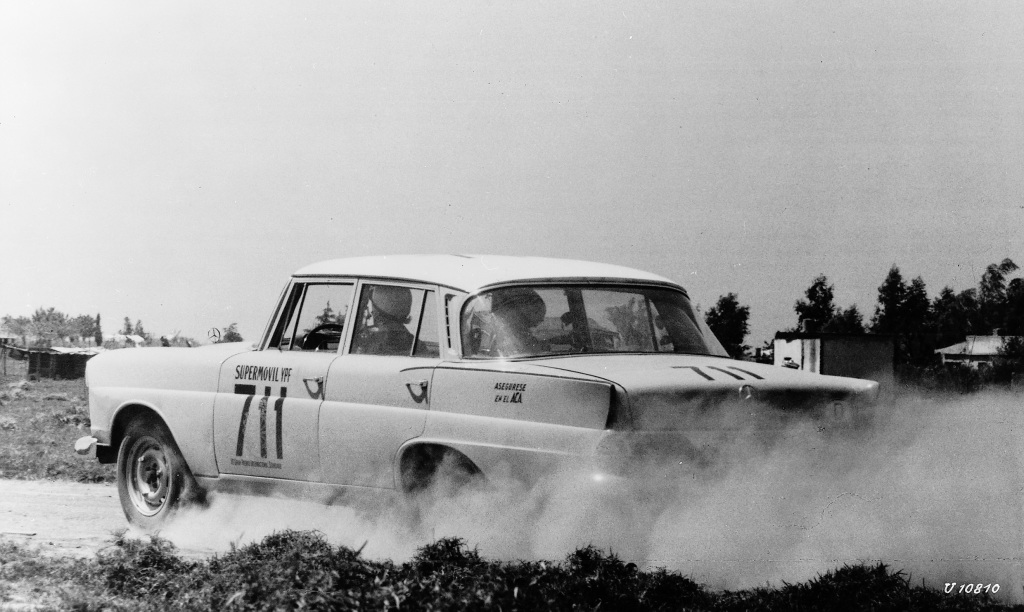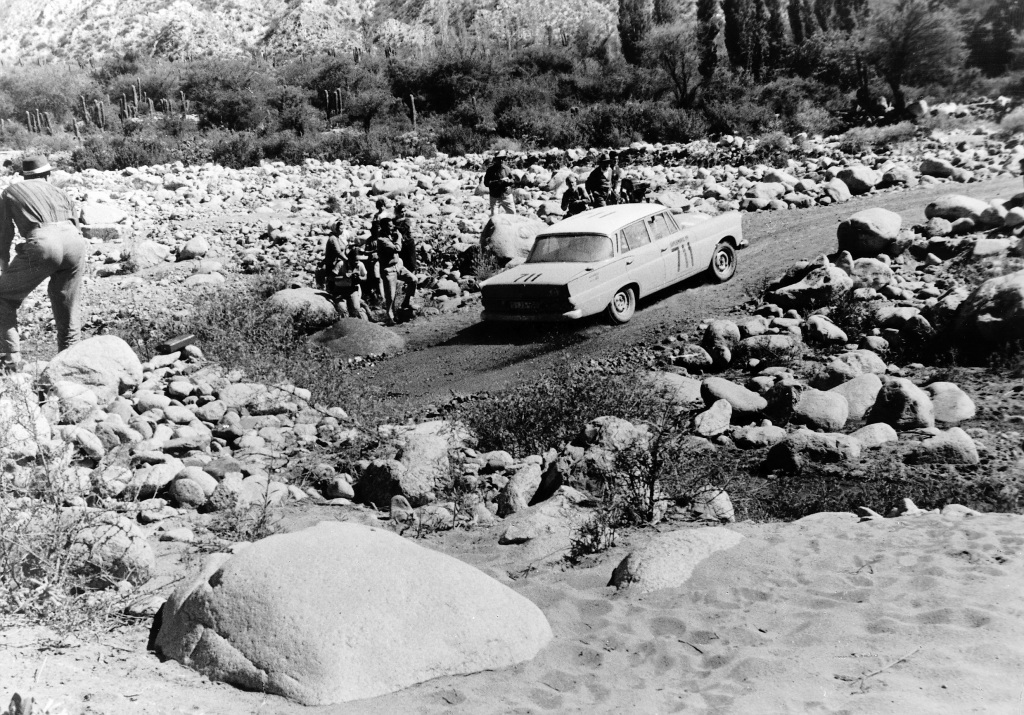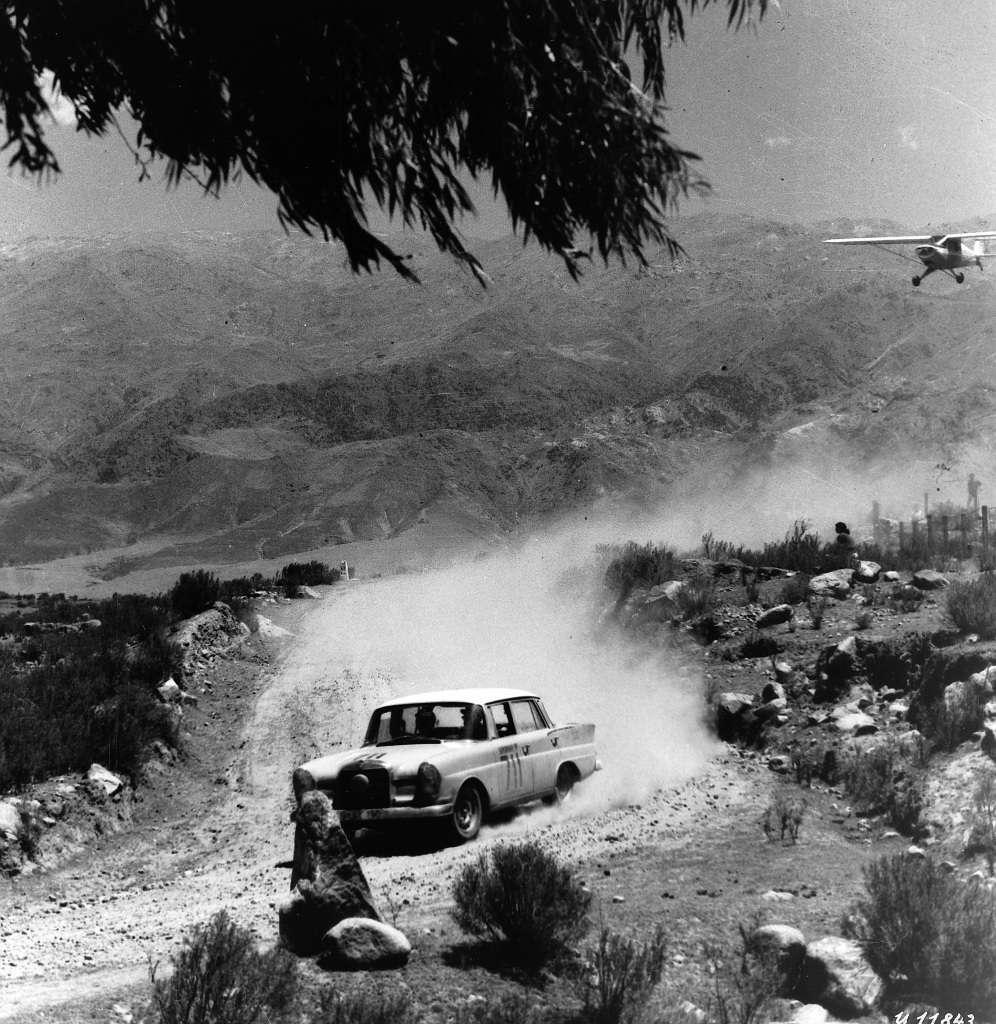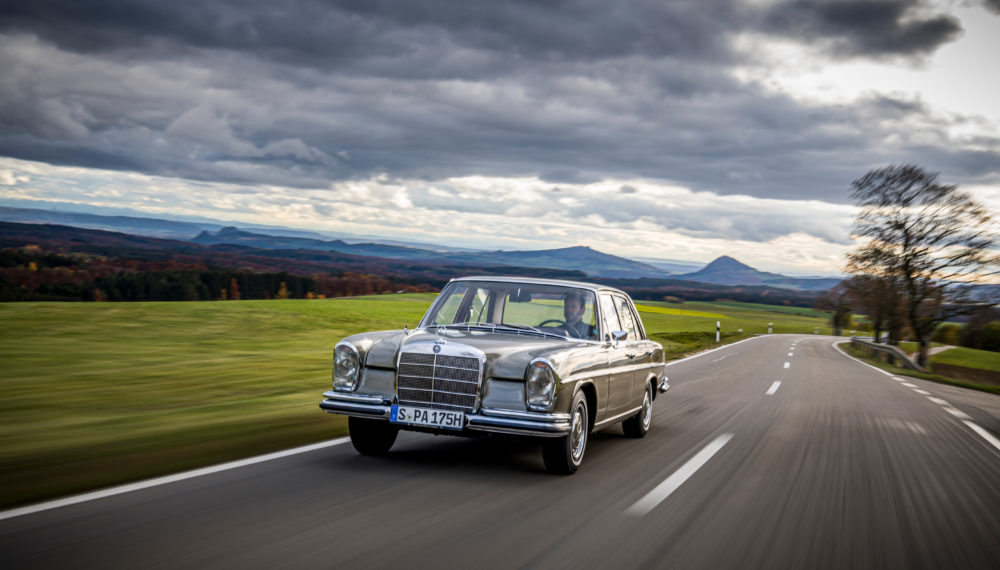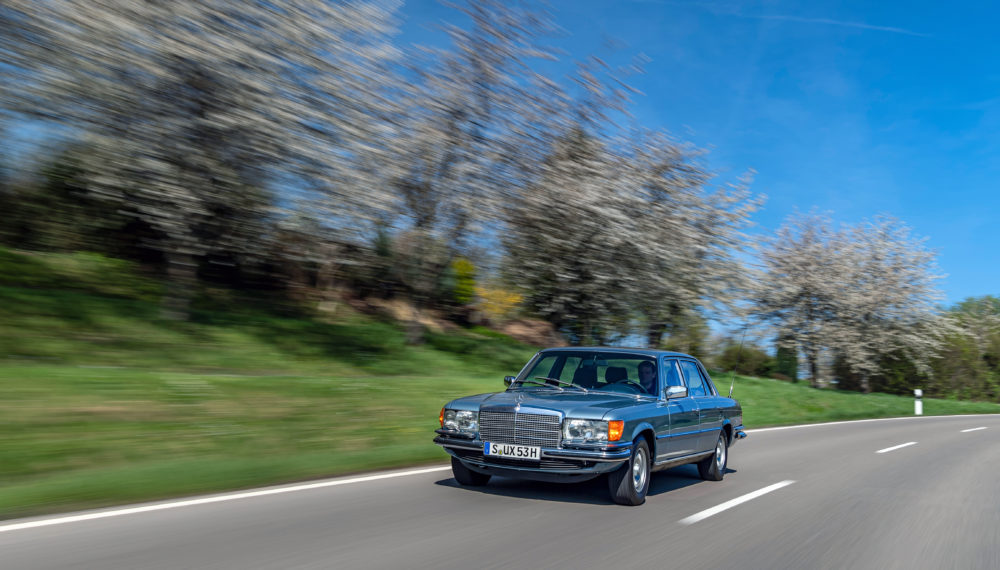On November 4, 1962, after completing 4626 kilometres, Ewy Rosqvist and her co-driver Ursula Wirth emerged victorious in the VI Touring Car Grand Prix of Argentina (“VI Gran Premio Internacional Standard Supermovil YPF”) in their Mercedes-Benz 220 SE (W 111). The entire country excitedly celebrated the outstanding victory of the Mercedes-Benz women’s team in South America’s tough long-distance rally.

Rennfahrerin Ewy Rosqvist
Racing Driver Ewy Rosqvist

Großer Straßenpreis für Tourenwagen in Argentinien vom 25. Oktober bis 4. November 1962. Siegesfeier im Hochhaus der Daimler-Benz AG in Stuttgart-Untertürkheim. Von links nach rechts: Ewy Baronin von Korff-Rosqvist, Generaldirektor Walter Hitzinger, Ursula Wirth und Rennleiter Karl Kling.
The Touring Car Grand Prix of Argentina, from 25 October to 4 November 1962. Victory celebrations in the Daimler-Benz AG tower block in Stuttgart-Untertürkheim. From left to right: Baroness Ewy von Korff-Rosqvist, Director General Walter Hitzinger, Ursula Wirth and Head of Racing Karl Kling

Ewy Rosqvist und Ursula Wirth, Gewinnerinnen des großen Straßenpreises von Argentinien (25.10.-04.11.1962) auf Mercedes-Benz 220 SE.
Ewy Rosqvist and Ursula Wirth, winners of the Argentinean Road Grand Prix (October 25 – November 4, 1962) driving a Mercedes-Benz 220 SE.

Großer Straßenpreis für Tourenwagen in Argentinien vom 25. Oktober bis 4. November 1962 über mehr als 4.600 Kilometer. Mercedes-Benz 220 SE (W 111) mit der Startnummer 711. Weiß lackiertes Dach, um die Sonnenstrahlung besser reflektieren und damit den Innenraum weniger aufheizen lassen.
The Touring Car Grand Prix of Argentina, from 25 October to 4 November 1962, took place over a distance of more than 4600 kilometres. The Mercedes-Benz 220 SE (W 111) with the starting number 711. The roof was painted white to reflect the sun´s rays better and therefore prevent the interior from heating up

Großer Straßenpreis für Tourenwagen in Argentinien vom 25. Oktober bis 4. November 1962 über mehr als 4.600 Kilometer. Mercedes-Benz 220 SE (W 111) mit der Startnummer 711. Weiß lackiertes Dach, um die Sonnenstrahlung besser reflektieren und damit den Innenraum weniger aufheizen lassen.
The Touring Car Grand Prix of Argentina, from 25 October to 4 November 1962, took place over a distance of more than 4600 kilometres. The Mercedes-Benz 220 SE (W 111) with the starting number 711. The roof was painted white to reflect the sun´s rays better and therefore prevent the interior from heating up

Sportliches Duo: Das schwedische Mercedes-Benz Damenteam Ewy Rosqvist und Ursula Wirth, aufgenommen im Jahr 1963.
Sporting duo: The Swedish Mercedes-Benz ladies’ team of Ewy Rosqvist and Ursula Wirth, picture in 1963.

Großer Straßenpreis für Tourenwagen in Argentinien vom 25. Oktober bis 4. November 1962. Das siegreiche schwedische Sieger Damenteam Ewy Rosqvist (rechts) / Ursula Wirth mit Rennleiter Karl Kling (Mitte).
The Touring Car Grand Prix of Argentina, from 25 October to 4 November 1962. The successful winning Swedish women´s team of Ewy Rosqvist (right)/Ursula Wirth, with Head of Racing Karl Kling (centre)

Großer Straßenpreis für Tourenwagen von Argentinien, 4. November 1962. Das schwedische Damenteam Ewy Rosqvist / Ursula Wirth, gewinnt auf einem Mercedes-Benz Typ 220 SEb W 111.
November 1962. Ewy Rosqvist / Ursula Wirth, wins the Grand Prix from Argentina on Mercedes-Benz (type 220 SEb W 111.)
Prior to the race the two Swedish women had been derided somewhat, however by the end of the race they had shown the public and the competition what they were made of: Rosqvist and Wirth not only finished the race as overall winners, they literally dominated the gruelling contest from the word go. In 1962, for the first time, a single vehicle won all six stages of the Grand Prix in succession, and in doing so the two Swedish women also set a new record.
This victory not only caused a sensation in Argentina – the outstanding success of Rosqvist and Wirth took the whole world by storm. In addition to an appreciation of their sporting achievement, there was also amazement at the fact that two women were able to succeed in this exceptionally gruelling contest against a field of competitors made up exclusively of men.
At the start of the 1960s, top international female athletes were still very rare in many disciplines. This is confirmed by a report from the news magazine “Der Spiegel” dating from 1966, which portrayed the two Swedish female racing drivers, together with female marathon runners and other female endurance athletes, as pioneers of female high-performance sport.
Ewy Rosqvist was certainly no novice in the sport of motor racing when she set off on behalf of Mercedes-Benz in the 1962 Grand Prix of Argentina. Born in 1929 in Ystad in southern Sweden, she was the daughter of a farmer and learned to drive at an early age. Her first car was a Mercedes-Benz 170 S, bought for her by her father.
Working as a veterinary assistant, she gained a great deal of experience driving on long, poorly built roads: “The driving which I […] had to carry out each day amounted to between 150 and 200 kilometres, almost all on unpaved roads, gravel paths and farm roads,” explained Ewy Rosqvist in her book “Fahrt durch die Hölle” [Driving through Hell] (Munich: Copress-Verlag 1963).
In 1954, Rosqvist experienced her first rally – as a passenger in the Midnight Sun Rally, which her husband and father were competing in. “That was so much fun that I decided to take part in a rally myself, or as a co-driver, as soon as possible,” the female driver recalled. And indeed – two years later, the young woman also found herself on the starting line of the Midnight Sun Rally. In 1959, Rosqvist won the European Rally Championship Women’s Cup for the first time in a Volvo. The then Daimler-Benz AG subsequently took on the successful female driver in the spring of 1962, as part of the Mercedes-Benz works team.
In the autumn of 1962, Mercedes-Benz sent a total of four works teams to Argentina, where in the previous year Manfred Schock and his co-driver Manfred Schieck had won the Grand Prix for Mercedes-Benz for the first time (the Mercedes-Benz team of Hans Herrmann/Rainer Günzler finished in second place). In addition to Rosqvist and Wirth in the 220 SE bearing the starting number 711 and the registration number S-LH 839, also on hand were Hermann Kühne and Manfred Schieck, also in a 220 SE (starting number 719), as well as Eugen Böhringer/Peter Lang (starting number 731) and Carlos Menditegui/Augustin Linares (starting number 703), each in W 112 model series Mercedes-Benz 300 SE models. Juan Manuel Fangio, the Argentine chief driver of the Mercedes-Benz racing division in 1954 and 1955, also accompanied the team during the 1962 Grand Prix.
The Stuttgart team under the direction of Karl Kling made use of the day before the start of the race to drive along the 4624-kilometre route so that the co-drivers could memorise the details of the course and make notes. During the rally, the route was broken down into six stages of between 515.4 and 863.5 kilometres. After setting out from Buenos Aires, it headed to Villa Carlos Paz, San Juan, Catamarca, Tucuman, Cordoba and back to Buenos Aires again. A one-day break was arranged between each of the race days.
A total of 286 cars registered for the Grand Prix, divided into seven different classes for the highly demanding event. Of these, 258 vehicles actually started the race but only 43 made it to the finish – less than one fifth. The other three Mercedes-Benz works teams also dropped out. A particularly tragic twist here was the fatal accident suffered by Hermann Kühne during the second stage.
Before the start, the newspapers still somewhat ridiculed the fact that a women’s team were setting out on the marathon rally through Argentina. When Rosqvist and Wirth chalked up a victory on the first stage, their success was soon praised as a respectable achievement. However, when the duo then also won the second stage, there was no more holding back and the Swedish women were wildly celebrated by the country’s media. The state of the nation at that time was captured in the German language newspaper “Freie Presse”, which was published in Buenos Aires: “It was not the Cuban missile crisis, but rather the two blondes from Scandinavia who dominated the headlines in the country’ s daily newspapers.”
By the end of the Grand Prix, Ewy Rosqvist and Ursula Wirth had won all six stages of the rally. The pair topped the overall rankings with a time of 34:51:03 hours, more than three hours ahead of the second-placed Boris Stipic, and also A.V. del Carril in third place (both in Volvos). The average speed of the winners was 126.87 km/h – a new record. To put this in context, Walter Schock had won the previous year’s “Gran Premio Internacional Standard Supermovil YPF” with an average speed of 121.23 km/h.
The vehicle with which Rosqvist and Wirth won the race was a virtually near production standard vehicle from the W 111 model series. Mercedes-Benz had purposely sourced a vehicle with regular steering as this gave more sensitive steering feedback. Only on the difficult mountain stages would Ewy Rosqvist have preferred a car with hydraulic power steering, as she wrote in a report on her Argentine experience: “Today I would have given anything for a power steering system!”
The victory of Rosqvist/Wirth in 1962 was the second success achieved by Mercedes-Benz at the “Gran Premio Internacional Standard Supermovil YPF” in a row. And in the following two years vehicles from Stuttgart again dominated the competition, which was followed with a great deal of interest in the important American market. In 1963 and 1964, Eugen Böhringer/Klaus Kaiser emerged victorious in each case in a Mercedes-Benz 300 SE. In 1963, Ewy Rosqvist finished in third place with Ursula Wirth as co-driver in a 220 SE, and in 1964 she again secured third place, this time with Eva-Maria Falk in a 300 SE.
Did you know …?
The Mercedes-Benz S-Class is the star of the Classic Calendar 2013. Under the title “Tribute to Art and Craft: Mercedes-Benz meets Mimmo Rotella”, the calendar merges 12 unique works with images of classic S-Class models in a new production by Monty Shadow. Available from October 2012 in the shop from .
